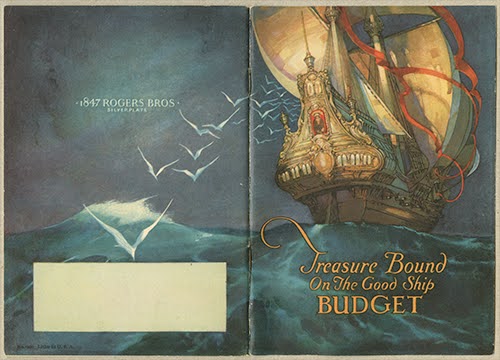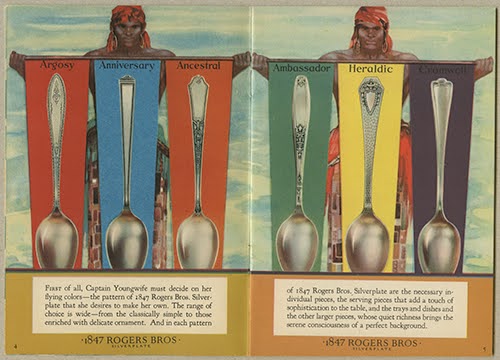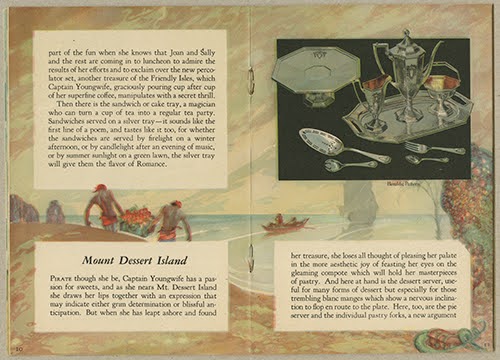 |
| This hidden mural painting was discovered during a renovation of Gustaf Tenggren's home and studio on Southport Island, Maine. The restoration is made by Fogg & Dalton Art Restoration, Maine. |
In 1944, Gustaf and Mollie Tenggren bought a property on Southport Island, Maine, where they were to spend the rest of their days. The old seaman’s homestead required a considerable renovation to make it suitable for living, accommodating guests and, above all, give Gustaf the peace and space to work intensly. With the help of local workers, Gustaf undertook a thorough remodeling and turned the place into an appropriate combined home and studio. Much of the work was done by himself, including the masoning of a giant fireplace, 10 ft wide and large enough enough to burn 6 ft logs.
After Gustaf’s death in 1970 and later Mollie’s death in 1984, the property was sold, and has apparently had a few owners up to this date. Just recently, the art restoration company Fogg & Dalton in Maine carried out an impressive work, renovating a mural painting on this very fireplace. The fireplace had been damaged in a earlier refurbishing and built in to cover it. The present owners had removed the covering walls and discovered the fireplace with the decorated mantelpiece. Now, they wanted it to be restored, which has been done with the most accuracy and respect to Gustaf’s original intentions.
 |
| Gustaf Tenggren by his fireplace, at this time undecorated. On the mantelpiece sits a few of the large collection of Swedish antiques he bought in 1945. From a Christmas card, 1940ies. |
From the beginning, the fireplace was lacking any decoration, save for a number of Swedish antiques kept on the mantelpiece. But in the 1960ies, when Gustaf’s commissions had reduced, he seemed to find the time to apply a mural painting to it. A number of sketches, now kept in the archives of The Weisman Museum of Art in Minneapolis, MA, shows how the idea was developed into the finished mural. I am deeply grateful to the
Weisman Art Museum for providing and letting me use their images for this article.
 |
Initially, Gustaf Tenggren meant to decorate the total front of the fireplace. Eventually, he only painted the sides and front of the mantelpiece.
Gustaf Tenggren, Untitled, 20th century, pencil on paper. Collection of the Weisman Art Museum at the University of Minnesota, Minneapolis. Bequest of Mollie Froberg Tenggren. 1985.33.171
|
 |
Details for the decorations include a gryphon.
Gustaf Tenggren, Untitled, 20th century, pencil on paper. Collection of the Weisman Art Museum at the University of Minnesota, Minneapolis. Bequest of Mollie Froberg Tenggren. 1985.33.169 |
 |
For some parts of the decorations, Gustaf seems to have been inspired by rune stones.
Gustaf Tenggren, Untitled, 20th century, pencil on paper. Collection of the Weisman Art Museum at the University of Minnesota, Minneapolis. Bequest of Mollie Froberg Tenggren. 1985.33.168 |
In line with his return to his Swedish cultural heritage during his later years, Gustaf has been inspired by the myths and legends of the Nordic viking tales, applying onto them a modern, (at the time) stylized form. The decorative style reminds of the illustrations for some of the last books he illustrated: ”The Canterbury Tales” from 1961 and ”King Arthur and the Knights around the Round Table” from 1962. This mural work was probably made shortly after that.
 |
The sketches for the mantelpiece starts to find its eventual form.
Gustaf Tenggren, Untitled, 20th century, pencil on onionskin paper. Collection of the Weisman Art Museum at the University of Minnesota, Minneapolis. Bequest of Mollie Froberg Tenggren. 1985.33.166 |
 |
Thor's arm with his hammer is introduced, referring to the fights Thor had with the serpent.
Gustaf Tenggren, Untitled, 20th century, pencil on onionskin paper. Collection of the Weisman Art Museum at the University of Minnesota, Minneapolis. Bequest of Mollie Froberg Tenggren. 1985.33.164 |
Gustaf has chosen to illustrate a mythological scene where two dragon ships are attacked by the giant sea serpent, Midgårdsormen. This was a frightful creature, large enough to embrace the whole World and bite its own tale. Gustaf has included some early petroglyphs, i. e. carving onto rock faces, depicting a hunter, a horse and a viking ship. Following the shape of the serpent he has written ”RAGNARÖK” , meaning the end of the World, and ”FENRISULVEN”. The latter is a misunderstanding by Tenggren; Fenrisulven is really a large wolf, a sibling of Midgårdsormen. Tenggren has mixed them up. The sketches originally included Thor's arm and hammer, referring to Thor's fight with the serpent. It was eventually exchanged for another dragon ship.
 |
An early colorized sketch for the final motif, still with Thor's arm. An interesting fact is that Gustaf still use the Acme Animation register punch holes he used during his years at the Disney Studio 1936 – 1939. In the early 1940ies, he planned to produce animated movies and apparently bought a hole punch and register tabs for that reason.
Gustaf Tenggren, Untitled, 20th century, watercolor and gouache on paper. Collection of the Weisman Art Museum at the University of Minnesota, Minneapolis. Bequest of Mollie Froberg Tenggren. 1985.33.167 |
 |
This late sketch is starting to find its eventual form, though still with Thor's arm.
Gustaf Tenggren, Fenrisulven, 20th century, pen, pencil and gouache on onionskin paper. Collection of the Weisman Art Museum at the University of Minnesota, Minneapolis. Bequest of Mollie Froberg Tenggren. 1985.33.165 |
My knowledge of runes is rudimentary, so anyone capable to decipher the runes inserted is greatly encouraged to do so.
 |
| Gustaf Tenggren by his decorated fireplace in the 1960ies. The image shows that the decorations were applied on the sides as well. The front remained blank, though initially meant to be decorated. |
 |
| When Fogg & Dalton received the commission to restore the mural, the fireplace was built in and hidden. It was discovered during a remodeling by the new owners. |
Since the fireplace was cut and shortened in the earlier refurbishing, the end of the serpent was improvised by Fogg & Dalton. They did not know of the sketches at the time, but has made a great job restoring the monster’s tail in a plausible way.
 |
| The lost parts of the fireplace was rebuilt and the total was re-plastered and painted. There was no images of the original so the motif had to be imagined and applied. The result is quite credible. |
I am very thankful to Fogg & Dalton for letting me use their images for the article. Go to their webplace to see their tremendous work:
FOGG & DALTON ART RESTORATION










































